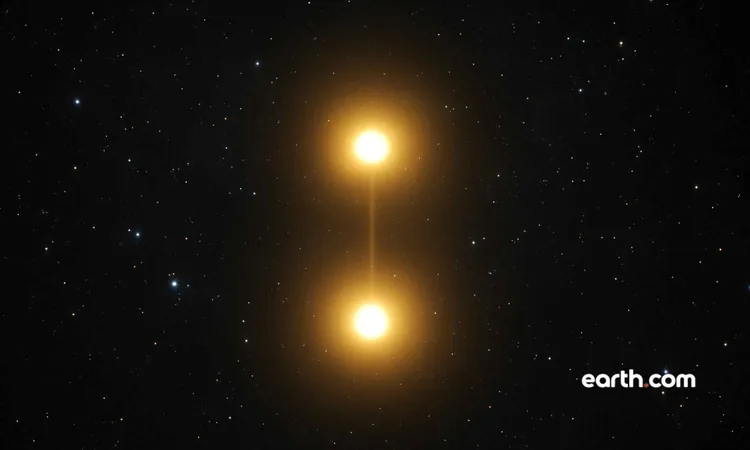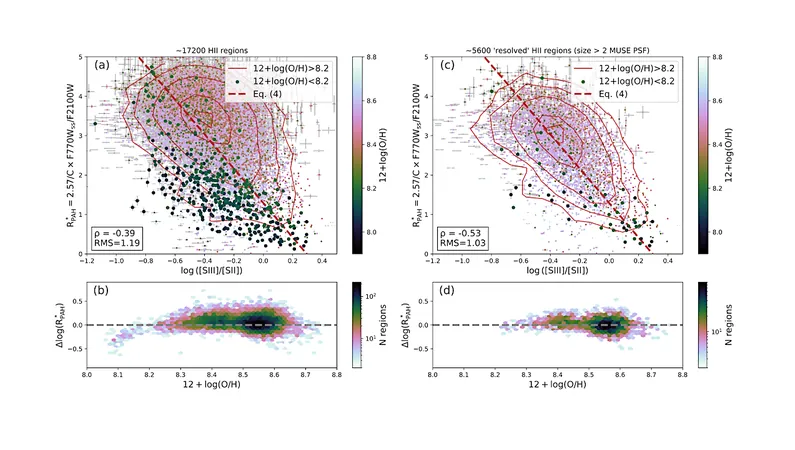
Revolutionary Discovery: Binary Stars as Beacons for New Planetary Systems
2025-07-13
Author: Mei
Astronomers have unveiled an exciting new strategy for discovering planets, and it all starts with binary stars— those mesmerizing cosmic couples that orbit together in perfect harmony.
A groundbreaking study reveals that when two stars align edge-on from our perspective on Earth, they can signal the presence of planets that are far easier to detect than usual. "This could open up an unprecedented avenue for examining the orderly processes of planet formation," explained Malena Rice from Yale University, the study's lead author.
Why Binary Stars Are Key Players
Many sun-like stars are not solitary; they share their existence with at least one companion, forming binary systems. When these twin stars orbit in a flat plane that aligns with our line of sight, telescopes can observe their movement toward and away from us. This unique perspective amplifies the slight wobbles caused by nearby orbiting planets, making them much easier to identify.
Previous surveys utilizing data from the Kepler and TESS missions indicated that planets within binary systems located less than 74 billion miles apart often align with their stars from the very beginning, suggesting a natural order during their formation. This alignment hints that the presence of a companion star may stabilize the protoplanetary disk, creating a more organized environment for planet formation.
Transforming Stars into Search Maps
Rice and her team meticulously sifted through the Gaia DR3 catalog, narrowing down 20 million entries to focus on nearly 600 bright, nearby binary systems whose motion suggests an edge-on view. The European Space Agency’s Gaia satellite captures minute positional changes, enabling them to compute the orbital tilts of these binaries with exceptional precision.
By simulating thousands of hypothetical planets around each qualified star, the researchers assessed how many could potentially be detected using today's advanced telescopic technologies. The favorable alignment not only enhances radial velocity signals but also increases the likelihood of detecting planets via the transit method, where planets pass in front of their host stars.
Creating a Stellar Shortlist
The end result? A meticulously curated catalog of 591 binaries, each exhibiting brightness brighter than magnitude 14 and separated by less than two arcseconds in the sky. This close spacing is crucial since the high-precision spectrographs used for starlight analysis can effectively isolate light without interference from the companion stars.
Notably, nearly 90% of the identified stars belong to the FGK temperature class, closely resembling our Sun, which optimizes conditions for stable observations. Further refinement excluded some hotter stars, leaving 940 individual suns ideal for velocity analysis, with two-thirds showing minimal magnetic interference that aids in detecting planetary signals.
What Awaits Discovery?
With a precision goal set at just 1 meter per second, their simulations suggest that about 74% of these targets could reveal at least one planet within three years of monitoring. Even setting a higher detection threshold still indicates that a significant fraction of stars harbors detectable worlds.
While planetary transits are less frequent, the potential for rich discoveries remains. Given the right conditions, a select few binary systems might even host two distinct planetary systems visible simultaneously, providing a unique opportunity for comparative studies of planet formation.
The Road Ahead for Binary Star Research
This expansive catalog paves the way for astronomers across both hemispheres to target unused observation nights and enhance ongoing exoplanet surveys. It also presents ideal candidates for upcoming monumental telescopes like the Thirty Meter Telescope and ESO’s Extremely Large Telescope, which promise to detect larger planets that existing methods might miss.
Future investigations aim to measure stellar rotation periods, determining if the stars align with their orbital motions and confirming that any detected planets have maintained their original formation alignment, avoiding subsequent chaos.
The next release from Gaia may even reveal subtle wobbles of massive outer planets, providing direct mass estimates that complement existing data.
Meanwhile, citizen-science initiatives like the Eclipsing Binary Patrol continue to uncover new edge-on pairs, ensuring a continuous influx of fresh targets each year.
Though this innovative approach may not capture every type of planet, particularly those with highly inclined orbits or isolated stars, it significantly boosts the chances of discoveries. For the first time, astronomers can compare sister worlds born in the same cosmic environment, inviting a new era of exploration in understanding planetary formation.
This exciting research has been published in The Astrophysical Journal Letters.




 Brasil (PT)
Brasil (PT)
 Canada (EN)
Canada (EN)
 Chile (ES)
Chile (ES)
 Česko (CS)
Česko (CS)
 대한민국 (KO)
대한민국 (KO)
 España (ES)
España (ES)
 France (FR)
France (FR)
 Hong Kong (EN)
Hong Kong (EN)
 Italia (IT)
Italia (IT)
 日本 (JA)
日本 (JA)
 Magyarország (HU)
Magyarország (HU)
 Norge (NO)
Norge (NO)
 Polska (PL)
Polska (PL)
 Schweiz (DE)
Schweiz (DE)
 Singapore (EN)
Singapore (EN)
 Sverige (SV)
Sverige (SV)
 Suomi (FI)
Suomi (FI)
 Türkiye (TR)
Türkiye (TR)
 الإمارات العربية المتحدة (AR)
الإمارات العربية المتحدة (AR)